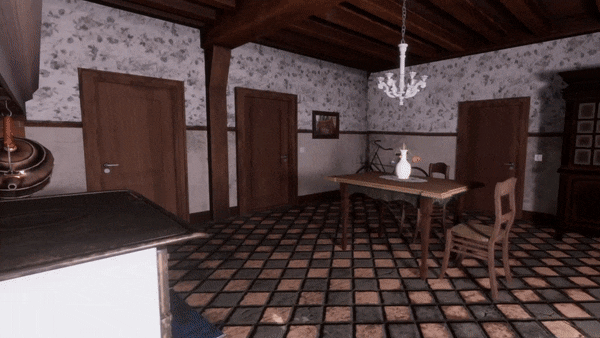Brukel VR Research Edition
In a study, I collaborated with a talented team to adapt the critically acclaimed game Brukel for a virtual reality environment. This project allowed us to push the boundaries of immersive storytelling by converting the rich, narrative-driven experience of the original game into a fully realized VR experience. My role involved working under the mentorship of Dr. Bob De Schutter, the original creator of the game, where we addressed the unique challenges of VR adaptation. We created an engaging and authentic Brukel VR experience successfully, focusing on a small introduction section and developing mechanics and systems that can be translated to the entire game. While it's still a work in progress, our efforts aim to enhance the immersive potential of this remarkable narrative.
Disclaimer: I was not the owner of the game "Brukel" but actively contributed to the Student Research Edition of the game. The intellectual property rights for the game "Brukel" are owned by LifeLong LLC. Link to Original Game
VR Locomotion
For our Brukel VR adaptation, we integrated a teleportation system with a blink effect for player movement. This choice, backed by extensive user testing and research, addresses VR-induced motion sickness, a common VR issue, promoting more accessible gameplay. The blink effect prevents disorientation, maintaining immersion. Our final locomotion mechanic reflects a user-centric approach refined through consistent user feedback.
Interactive Elements in Environment
In our VR adaptation of Brukel, we introduced interactive elements to promote deeper immersion and engagement. Objects like curtains and lights are made interactable, allowing players to engage with their surroundings physically. This fosters a sense of presence and makes the environment feel more tangible. These interactions were designed carefully, following meticulous testing and user feedback, to ensure they felt intuitive and added value to the gameplay rather than serving as mere gimmicks.
VR Implementation of the Mobile
In the VR adaptation of Brukel, we aimed to transform the in-game mobile into a physical, interactable object in the player's hand. Our initial approach involved replacing the original 2D interface with an interactive screen, operable through VR controls that mimic the touch-screen interaction by using the thumb on the controller's joystick. This significant change was conceptualized with the goal of further immersing players by emulating real-world smartphone use. While this concept holds promise, it requires more extensive user testing and refinement to ensure seamless integration and an intuitive, lifelike interaction with this crucial game element.
VR Adaptation of the UI
In our VR adaptation of Brukel, we strategically transformed the game's UI to suit the immersive nature of VR. We transitioned traditional 2D UI elements into an interactive 3D space, ensuring an intuitive and immersive user experience. Key in-game items, previously interacted with via traditional UI, were reimagined as tangible objects within the VR space.
For important text-based information, such as subtitles, we devised a solution that minimized disruption of the immersive experience. Instead of a traditional overlay, we integrated subtitles into the game world as a UI element tethered to the player's virtual hand. This approach ensured that vital information remained accessible while preserving immersion.
My Contributions
In adapting Brukel Research Edition into a Virtual Reality format, I played an integral role in the two-member team tasked with this project. The original game, developed by LifeLong Games LLC, provided us with the source code and assets required for the transformation.
Project Upgrade: I took the helm in updating the entire project from Unreal Engine 4.26 to the more robust and feature-rich Unreal Engine 5.1. This was a critical step, ensuring compatibility with the latest VR headsets and plugins and setting the stage for the VR adaptations we intended to make.
Performance Optimization: Recognizing the inherent performance demands of a VR game, I spearheaded optimization efforts to improve game performance. By incorporating advanced features like Virtual Texturing, Nanite, and Virtual Shadow Maps, and leveraging a mix of Baked Lighting and Lumen, I was able to significantly boost the game's frame rate. This ensured a smooth, immersive gameplay experience on various system configurations while maintaining a high-quality visual presentation in VR.
Interaction System Creation: Understanding the need for seamless and intuitive player interactions in VR, I developed a new VR-supported interaction system that worked compatibly with the pre-existing system in the non-VR game. This ensured continuity in gameplay while leveraging the immersive opportunities of VR.
VR-Supported UI Adaptation: I led the transition of the game's UI to a VR-compatible format. This included innovative changes like transforming the smartphone – a vital gameplay element – from a 2D UI element to a physically interactable object within the VR space. Balancing usability and immersion, I ensured that the UI would enhance, rather than impede, the player's experience in the VR adaptation of Brukel.




